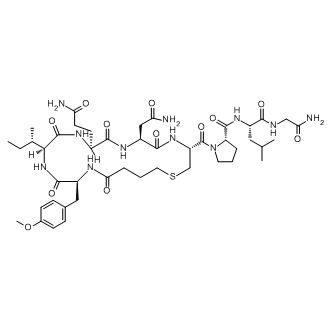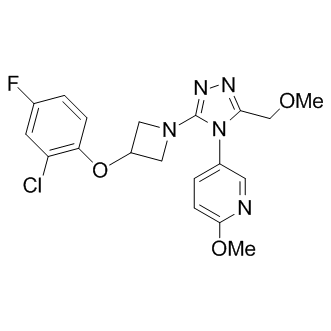 To enhance service speed and avoid tariff delays, we've opened a US warehouse. All US orders ship directly from our US facility.
To enhance service speed and avoid tariff delays, we've opened a US warehouse. All US orders ship directly from our US facility.
| Cat. No. | Product Name | Field of Application | Chemical Structure |
|---|---|---|---|
| DC9553 | Carbetocin Featured |
Carbetocin (marketed under brand names such as Lonactene and Duratocin) is a synthetic analogue of oxytocin, specifically designed for use in obstetrics to prevent and manage postpartum hemorrhage (PPH), a leading cause of maternal mortality worldwide. It is a long-acting agonist of peripheral oxytocin receptors, making it highly effective in inducing uterine contractions and reducing bleeding after childbirth.
More description
|

|
| DC70134 | Oxytocin Featured |
A peptide hormone and neuropeptide that is released into the bloodstream as a hormone in response to stretching of the cervix and uterus during labor and with stimulation of the nipples from breastfeeding.
More description
|

|
| DC7480 | PF-3274167(cligosiban) Featured |
PF-3274167 is a high-affinity nonpeptide oxytocin receptor (OTR) antagonist, with Ki of 9.5 nM.
More description
|

|
| DC72128 | L-368,899 |
L-368,899 is an orally active and selective OT (oxytocin ) receptor antagonist, with IC50s of 8.9 and 26 nM for uterus of rat and human, respectively. L-368,899 can cross the blood-brain barrier (BBB). L-368,899 inhibits oxytocin-stimulated uterine contractions in rats and can be used in study of preterm labor.
More description
|

|
| DC9552 | Oxytocin (acetate) Featured |
Oxytocin (α-Hypophamine) acetate is a mammalian neurohypophysial hormone; its actions are mediated by specific, high-affinity oxytocin receptors; ligand of oxytocin receptor.
More description
|

|
| DC47258 | Carbetocin acetate |
Carbetocin acetate, an oxytocin (OT) analogue, is an oxytocin receptor agonist with a Ki of 7.1 nM. Carbetocin acetate has high affinity to chimeric N-terminus (E1) of the oxytocin receptor (Ki=1.17 μM). Carbetocin acetate has the potential for postpartum hemorrhage research. Carbetocin acetate can crosse the blood-brain barrier and produces antidepressant-like activity via activation of oxytocin receptors in the CNS.
More description
|

|
| DC46970 | L-372662 |
L-372662 is a potent and orally active non-peptide oxytocin antagonist with a Ki value of 4.8. The Kd value of L-372662 for wild-type hOTR and [A318G]OTR is 5.8 nM and 73 nM. L-372662 shows selectivity to OTR:V1aR.
More description
|

|
| DC45573 | [Asp5]-Oxytocin |
[Asp5]-Oxytocin is the first 5-position neurohypophyseal hormone analogue possessing significant biological activity.
More description
|

|
| DC41072 | Retosiban |
Retosiban (GSK221149A) is a potent and selective oxytocin antagonist with a Ki of 0.65 nM.
More description
|

|